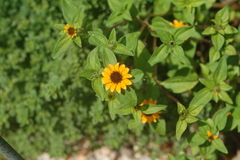Sanvitalia
| Sanvitalia subsp. var. | Creeping Zinnia | |||||||||||||||||||||||||||||||||||||||||||||||||||||||
|---|---|---|---|---|---|---|---|---|---|---|---|---|---|---|---|---|---|---|---|---|---|---|---|---|---|---|---|---|---|---|---|---|---|---|---|---|---|---|---|---|---|---|---|---|---|---|---|---|---|---|---|---|---|---|---|---|

|
|
| ||||||||||||||||||||||||||||||||||||||||||||||||||||||
| ||||||||||||||||||||||||||||||||||||||||||||||||||||||||
| Standard Cyclopedia of Horticulture |
|---|
|
Sanvitalia (after a noble Italian family). Compositae. Usually low, much-branched herbs grown for their attractive yellow flowers. Leaves opposite, petioled, mostly entire: heads of fls. small, solitary, with yellow or sometimes white rays; involucre short and broad, of dry or partly herbaceous bracts; receptacle from flat to subulate-conical, at least in fr.; its chaffy bracts concave or partly conduplicate: achenes all or only the outer ones thick-walled, those of the rays usually 3-angled, with the angles produced into rigid, spreading awns or horns, those of the disk often flat and winged.—About 4 species, natives of the S. W. U. S. and Mex. May be grown as an annual in the open, but if given protection it will sometimes flower the second year. Sanvitalias are of easy culture but prefer a light or sandy soil in full sunlight. CH
|
Cultivation
- Do you have cultivation info on this plant? Edit this section!
Propagation
- Do you have propagation info on this plant? Edit this section!
Pests and diseases
- Do you have pest and disease info on this plant? Edit this section!
Species
Gallery
If you have a photo of this plant, please upload it! Plus, there may be other photos available for you to add.
-
photo 1
-
photo 2
-
photo 3
References
- Standard Cyclopedia of Horticulture, by L. H. Bailey, MacMillan Co., 1963
External links
- w:Sanvitalia. Some of the material on this page may be from Wikipedia, under the Creative Commons license.
- Sanvitalia QR Code (Size 50, 100, 200, 500)
